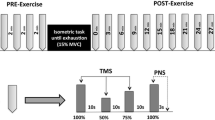Abstract
The process of muscular fatigue under cooling conditions (+10°C, 30 min) was studied on seven healthy volunteers (males aged 20 to 34 years) by the surface electromyography (EMG) method using the turn-amplitude analysis. A distinct stage pattern of changes in the parameters of the turn-amplitude analysis was revealed under thermoneutral conditions. The direction of EMG changes was retained in fatigued subjects in the cold; however, under mild exercise stress, the “thermoregulation” component of muscular fatigue was revealed.
Similar content being viewed by others
References
Lupandin, Yu.V., Meigal, A.Yu., and Sorokina, L.V.,Termoregulyatsionnaya aktivnost’ dvigatel'noi sistemy cheloveka (Thermoregulation Activity of the Human Locomotor System), Petrozavodsk: Petr. Gos. Univ., 1995.
Meigal A.Yu., Oksa, J., Hohtola, E.,et al.: Influence of Cold Shivering on Fine Motor Control in the Upper Limb,Acta Physiol. Scand., 1998, vol. 163, p. 41.
Oksa, J., Rintamaki, H., and Rissanen, S., Muscle Performance and Electromyogram Activity of the Lower Leg Muscles with Different Levels of Cold Exposure,Eur. J. Appl. Physiol., 1997, vol. 75, p. 484.
Oksa, J., Rintamaki, H., Makinen, T.,et al., EMG-Activity and Muscular Performance of Lower Leg during Stretch-Shortening Cycle after Cooling,Acta Physiol. Scand., 1996, vol. 157, p, 71.
Oksa, J., Rintamaki, H., Makinen, T.,et al., Cooling-induced Changes in Muscular Performance and EMG Activity of Agonist and Antagonist Muscles,Aviat. Space Environ. Med., 1995, vol. 66, p. 26.
Bell, D.G., The Influence of Air Temperature on the EMG/Force Relationship of the Quadriceps,Eur. J. Appl. Physiol., 1993, vol. 67, p. 256.
Meigal, A.Yu., Lupandin, Yu.V., and Hanninen, O., Influence of Cold and Hot Conditions on Postactivation in Human Skeletal Muscles,Pflugers Arch.-Eur. J. Physiol., 1996, vol. 432, p. 121.
Meigal, A.Yu., Gerasimova, L.I., Zolotova, E.V., and Lupandin, Yu.V., Voluntary Recruitment of Motor Units under Cold Shivering Conditions,Fiziol. Chel., 1998, vol. 23, no. 6, p. 64.
Gandevia, S.C., Neural Control in Human Muscular Fatigue: Changes in Muscle Afferents, Motoneurons and Motor Cortical Drive,Acta Physiol. Scand., 1998, vol. 162, p. 275.
Gerasimova, L.I., Meigal, A.Yu., Sergeev, A.M., and Lupandin Yu.V., Characteristics of Integrated Electromyogram in Diphtherial Polyneuropathy,Fiziol. Chel., 1998, vol. 24, no. 2, p. 85.
Fuglsang-Frederiksen, A., Interference EMG Analysis inComputer-aided Electromyography and Expert Systems, Desmedt, J.E., Ed., Elsevier, 1989, p. 161.
Ramanathan, N.L., A New Weighting System for Mean Surface Temperature of the Human Body,J. Appl. Physiol., 1964, vol. 19, p. 531.
Sakurai, G., Ozaki, J., Nishimoto, K., and Tamai, S., Electromyographic Analysis of Shoulder Joint Function of the Biceps Brachii Muscle during Isometric Contraction,Clin. Orthop., 1998, vol. 354, p. 123.
Dietz, V., Analysis of the Electrical Muscle Activity during Maximal Contraction and Influence of Ischemia,J. Neurol. Sci., 1978, vol. 37, p. 187.
Gerasimova, L.I., Meigal A.Yu., Sergeev, A.M., and Lupandin, Yu.V., Quantification of the Total Electromyogram in Patients with Diphtherial Polyneuropathy,Zh. Nevrol. Psikhiatr., 1999, vol. 99, no. 5, p. 25.
Miller, K.J., Garland, S.J., Ivanova, T., and Ohtsuki, T., Motor Unit Behavior in Humans during Fatiguing Arm Movements,J. Neurophysiol., 1996, vol. 75, p. 1629.
Patton, J.F. and Vogel, J.A., Effects of Acute Cold Exposure on Submaximal Endurance Performance,Med. Sci. Sport Exerc., 1984, vol. 16, p. 494.
Finsterer, J. and Mamoli, B., T/A Analysis, with or without Measuring Force: Problems in the Evaluation of Normal Limits,Electromyogr. Clin. Neurophysiol., 1994, vol. 34, p. 215.
Westerblad, H., Bruton, J.D., and Lannergren, J., The Effect of Intracellular pH on Contractile Function of Intact, Single Fibers of Mouse Declines with Increasing Temperature,J. Physiol. (London), 1997, vol. 500, p. 193.
Ferretti, G., Ishii, M., Moia, C., and Cerretelli, P., Effects of Temperature on the Maximal Instantaneous Muscle Power in Humans,Eur. J. Appl. Physiol., 1992, vol. 64, p. 112.
Author information
Authors and Affiliations
Rights and permissions
About this article
Cite this article
Meigal, A.Y., Ivukov, A.Y., Gerasimova, L.I. et al. The effects of general cooling on the electromyographic characteristics of muscular fatigue caused by dynamic load. Hum Physiol 26, 193–198 (2000). https://doi.org/10.1007/BF02760091
Received:
Issue Date:
DOI: https://doi.org/10.1007/BF02760091




